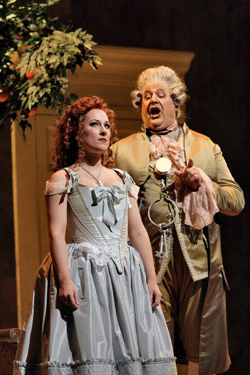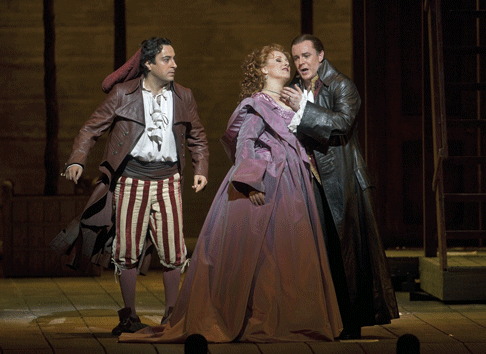16 Feb 2012
The Barber of Seville, Metropolitan Opera
It was a performance of Rossini’s The Barber of Seville in the late 90’s that marked my first visit to the Met.

It was a performance of Rossini’s The Barber of Seville in the late 90’s that marked my first visit to the Met.
As a young opera lover under the age of ten, my awe at the occasion requires no explanation. Needless to say, as I took my seat with the rest of my family in the Grand Tier, I felt like the ever-elusive “big kid” that young boys aspire to be. However, as soon as the conductor commenced the overture, to my consternation, I felt an overpowering urge to laugh. Therefore, what began as a potentially magical evening when a kid gets his first taste of adulthood was threatened by the possibility of immediately degenerating into a travesty. I was sure that if I had dared to laugh, some bejeweled grand dame would have given an inscrutable nod, leading directly to my removal from the auditorium.
My reason for laughing is quite simple: from the first bars of the overture, my brain immediately equated the music coming from the pit with the soundtrack of The Rabbit of Seville, the Looney Tunes cartoon starring Bugs Bunny and Elmer Fudd. Looking back on my first night at the Metropolitan Opera, I realize I must not be the only person that made that connection. Indeed, it is the very fact of the overture’s frenetic pacing, so characteristic of both Looney Tunes and Rossini, that allows the opera to speak so vividly to our modern times, just short of 200 years since the opera’s composition.
 Diana Damrau as Rosina and John Del Carlo as Dr. Bartolo [Photo: Ken Howard/Metropolitan Opera]
Diana Damrau as Rosina and John Del Carlo as Dr. Bartolo [Photo: Ken Howard/Metropolitan Opera]
According to Benjamin Walton, author of the book Rossini in Restoration Paris, Rossini can be classified as a Romantic composer, not because he offers grand philosophical statements on human nature like Wagner does, but rather because his music inhabits a domain that is utterly sensuous. The sensuousness of his music combined with its ebullient pace makes the composer’s work the embodiment of rushed modernity. Walton’s book, however, only utilizes this framework to analyze musical political developments in 1820’s Paris. I believe, however, that in this light, Rossini’s sense of modernity is perennial. His indulgent musical language describes the hyperactive 21st century just as easily as it described a world trying to make sense of the French Revolution and its consequences.
With this in mind, it makes sense that Peter Gelb would contract acclaimed Broadway director Bartlett Sher, of The Light in the Piazza and South Pacific fame, to direct a new production of The Barber of Seville. This production, which was revived again earlier this season, was recently brought back for its Spring run. In the cast, Diana Damrau and John Del Carlo reprised their respective roles as Rosina and Dr. Bartolo. Figaro was played by Rodion Pogossov, while Colin Lee sang the Count. The team was led by acclaimed Rossini interpreter Maurizio Benini.
Mr. Benini has proven himself adept in Rossini operas. In recent years, he has conducted both Barber and La Cerentola. He has even led the company’s recent debut of Le Conte Ory. In every case, he has shown he is quite adept at Rossini’s fast-paced orchestration. Here, however, he also demonstrated his ability to match speed with lyricism. He aptly demonstrated the composer’s facility with creating instrumental blends. However, once or twice, most notably during Don Basilio’s “La Calunia” and the Count’s “Cessa di piu resistere,” he seemed to lose his stamina, but that in no way diminished his reading.
As the Count, Colin Lee was the definition of Bel Canto singing. He showcased a delightfully streamlined vibrato as well as stunning legato. It was a joy to experience a coloratura tenor who actually availed himself of every opportunity to demonstrate every facet of his vocal technique. He also depicted a sharper side of the traditionally lovestruck Count. This allowed the Count and not just Bartolo and Basilio to be the noble objects of satire in this opera buffa. He demonstrated this by plucking a guitar from the hands of one of the musicians accompanying him in his opening serenade to Rosina, as well as smacking Figaro with a guitar later on in Act I.
In the hands of Diana Damrau, Rosina is not another role, she is a phenomenon. As a critic, familiarizing oneself with various interpretations of the same role is part of the job description. However, when Damrau exploded onto the stage for “Una voce poco fa,” she managed to sprint out of the gates, leaving Maria Callas, Beverly Sills, Lily Pons, and Roberta Peters breathless in her wake. Opera fans are no doubt well acquainted with the text of “Voce.” In a section lauded for technical prowess, Rosina states that although she can be docile, loving, and obedient, if her affections should be abused, she can bite with the sting of a viper and before admitting defeat, she can play one hundred tricks.
 Rodion Pogossov as Figaro, Diana Damrau as Rosina, and Colin Lee as Almaviva [Photo: Cory Weaver/Metropolitan Opera]
Rodion Pogossov as Figaro, Diana Damrau as Rosina, and Colin Lee as Almaviva [Photo: Cory Weaver/Metropolitan Opera]
In the hands of any other soprano, these are just words, and no matter how well they are interpreted, they are confined to that one aria. In Damrau’s hands, she physically and vocally turned that text into a credo, something her Rosina didn’t state but rather lived for the entirety of the role. Her attention to text was breathtaking. She bounced onto the word “vipera” (viper). Her runs at the end of “Voce” had a slow build. This was a very audible demonstration that she could turn anyone, perhaps even the audience, into mincemeat. Additionally, her trills in “Dunque io son,” reflected a whole new light on the character.
In Damrau’s hands, these runs were less an expression of joy at requited love and more an affirmation of determination to win the day. It was plain to see that now that she knew her love was reciprocated, she would redouble her attacks on Bartolo. Despite her brilliance at portraying Rosina as a vindictive ward, the true mastery of her interpretation showed through in the character’s intrinsic humanity. There were moments, such as the recitative immediately following “Voce,” as well as the Act II aria “Contro un cor,” which illustrated that despite the tough veneer, she was perhaps an innocent girl who was seriously afraid of getting hurt by the men around her. During “Contro un cor,” her statements of “Darling, I’m begging you to save me” were true pleas for help.
John Del Carlo was an appropriately self-important Bartolo. His adroit Rossinian patter was a joy to hear. Ferruccio Furlanetto was a marvelously theatrical Don Basilio. As Figaro, Rodion Pogossov was a true team player in an opera predicated on ensembles. Unfortunately, while his amazing physicality was an asset in this bubbling comedy, his rendition of the famous “Largo al factotum” was a little weak. While other baritones such as Sherrill Milnes avail themselves of the musical comedy of this opera through such techniques as falsetto, Pogossov was a decidedly physical comedian. Despite his stentorian voice, the musical comedy of this aria went largely untouched.
Since The Barber of Seville, Bartlett Sher has come back to the Met to revive Les Contes d’Hoffman and to debut Le Conte Ory. Barber remains a decent harbinger of what was to come. The comedy of this production is largely predicated on elementary tricks of theater, which use their obvious nature to increase the comic effect. He also incorporated images from the text. The set is dominated by doors, representing Rosina’s trapped lifestyle. Also, from his very first appearance sleeping under a sheet in an armchair while the overture is still being played, Dr. Bartolo receives his full treatment as the satirized nobleman that is such a hallmark of opera buffa. However, this production has one major flaw: the lighting design, done by Christopher Akerlind, was a bit off. It was clear he was going for the look of a sun-drenched Andalusian atmosphere; however, most notably in the opening scene, the lights, consisting primarily of overpowering yellows and greens, were harsh and off the mark.
Despite a few blemishes, the Met’s Barber of Seville has demonstrated the staying power of this opera by disclosing certain aspects that have previously been hidden. When I left the opera house, I had new respect for the piece. I was reminded of why audiences return to this beloved opera again and again, while at the same time, I discovered new depth to the work. In short, I left with the respect for the work’s humanity, as well as its effervescent joy.
Greg Moomjy